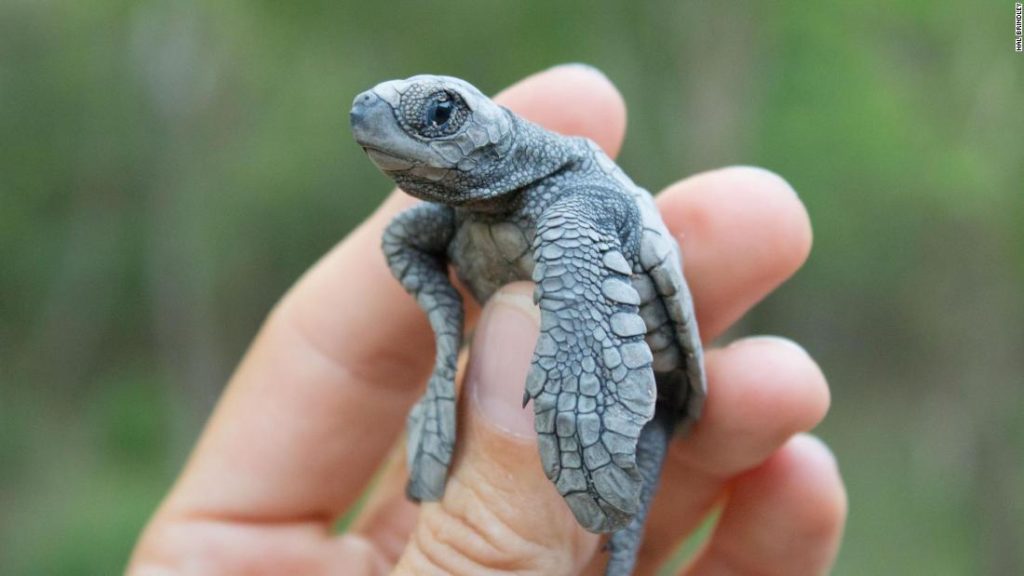“It just kept moving,” she says. “Every hour I’m checking, and it’s gone further and further.”
Pheasey, then a PhD student at the Durrell Institute of Conservation and Ecology in the UK, was tracking a stolen item — but not the usual type.
The dot was tracking the journey of a fake turtle egg, which Pheasey had planted deep within a real turtle nest the day before. The egg was poached and trafficked to a supermarket loading bay 137 kilometers (85 miles) away, where it was probably sold.
Dubbed an “InvestEGGator,” the fake turtle egg — roughly the size of a ping pong ball — was developed by scientists at US-based conservation organization Paso Pacifico, which focuses on protecting coastal ecosystems in Central America.
Made of a rubbery material called NinjaFlex, the fake eggs are daubed with a special textured paint — developed by Hollywood special effects artist Lauren Wilde — that gives off a yellowish tinge.
The fake eggs look and feel like the real thing, but hidden inside them is a SIM card with a GPS transmitter that uses mobile networks to transfer location data, and a USB port for charging.
Paso Pacifico developed the decoys as a tool to combat trafficking. The organization estimates that poachers destroy more than 90% of sea turtle nests on many of Central America’s unprotected beaches, to sell the eggs into the illegal wildlife trade.
In a two-year research project that began in 2017, Pheasey deployed 101 fake eggs in the nests of olive ridley and green sea turtles across four beaches in Costa Rica, to test their effectiveness in tracking trade routes.
Planting the fake eggs
If the fake eggs were taken from the nests, the SIM card would find a signal and send an alert with GPS coordinates to Pheasey.
“It’s just like your mobile phone,” she tells CNN. “If you bury your phone in the sand, you’re not going to have any signal. But as soon as they’re uncovered, they’ll come online.”
Of the 101 decoy eggs deployed, a quarter were illegally taken and five successfully provided tracks.
The tracks varied in length. One decoy traveled under 50 meters (160 feet) to the nearest beach house, one moved two kilometers (just over a mile) to the nearest bar, while another went 137 kilometers (85 miles) inland, providing solid evidence of the turtle egg trade.
In some cases, decoys’ journeys revealed the full trade chain: from the poacher, to a seller, to a customer’s residence, says Pheasey.
Policing illegal trade
This intelligence could help strengthen law enforcement by enabling authorities to target traffickers and criminal networks rather than local poachers, who are usually “marginalized individuals trying to make a quick buck,” says Pheasey.
“They’re now considered a delicacy and an aphrodisiac,” she tells CNN. “In many bars and restaurants, people will make turtle egg soup, or they’ll put a raw turtle egg in a drink.”
However, before the decoy eggs can be used effectively for conservation and law enforcement some hurdles remain. Paso Pacifico are working to extend the eggs’ battery life, which only lasts for a few days when the eggs are sending hourly location alerts.
Pheasey identified low signal reception in coastal areas as another possible limitation, but Otterstrom doesn’t see this as a major problem. “Even though there might be beaches that are remote and don’t have cell phone technology, as the eggs make their way towards markets, they will inevitably come across cell phone towers,” she says.
What’s important is that the tracking technology is affordable, widely available, and works in most countries around the world, so it can be used to identify cross-border trade, she says.
Paso Pacifico has sold its turtle egg decoys, at around $60 an egg, to conservation projects and law enforcement agencies, including one undisclosed South American government.
Otterstrom says that Paso Pacifico is planning to adapt the technology to work for other species whose eggs are vulnerable to illegal trade, such as parrots or crocodiles.
“Intelligence is key to prevention,” says Pheasey. “It means that you’re always ahead of the poachers rather than behind. We need to be proactive, not reactive.”
You may also like
-
Afghanistan: Civilian casualties hit record high amid US withdrawal, UN says
-
How Taiwan is trying to defend against a cyber ‘World War III’
-
Pandemic travel news this week: Quarantine escapes and airplane disguises
-
Why would anyone trust Brexit Britain again?
-
Black fungus: A second crisis is killing survivors of India’s worst Covid wave

